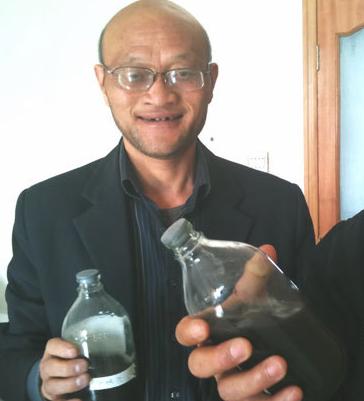Gov't vows to fight occupational disease
Some 200 million Chinese workers serving more than 30 sectors have been exposed to various health hazards in the workplace on the mainland, said Health Minister Chen Zhu at a conference on occupational disease control held in Hunan province on Tuesday.
 |
|
51-year-old coal miner Long Huaiwen underwent a lung lavage in Xinjiang Occupational Disease Hospital on October 18, which generated 48 bottles of black water.He has worked as a miner for 16 years. |
Despite government efforts to contain the diseases, including funding and stepped-up surveillance, the incident rate across the nation has increased in recent years, experts said.
There were more than 720,000 cases of occupational diseases reported in China in 2009, up nearly 32 percent over 2008, statistics from the Ministry of Health showed.
That might still be an underestimate, Chen conceded, citing experts' estimations.
"Given the unprecedented industrialization and urbanization under way, China has entered a period with a high prevalence of occupational diseases and is therefore facing steep challenges in controlling it," he said.
Pneumoconiosis, or black lung disease, as it is also known, accounted for more than 90 percent of cases and caused a direct economic loss of 8 billion yuan ($1.21 billion) each year, official statistics showed.
Each year, about 57,000 coal miners nationwide suffer from pneumoconiosis and 6,000 die of it.
A chronic disease resulting from long-term exposure to coal dust and other harmful materials, pneumoconiosis is widespread among coal miners, particularly those working at small and medium-sized mines with relatively poor working facilities.
The concentration of coal dust in most mine shafts far exceeds the national standard, leading to the rising incidence of pneumoconiosis, an industry insider said at the coal mining occupational safety and health meeting held in Shandong province on Tuesday.
"These employers have usually been found flouting rules and regulations in occupational disease prevention and control," Chen Zhu said.
"That sometimes led to mass incidents as infected workers campaigned for compensation," he said.
Chen called for increased efforts in disease surveillance and inspection work targeting workplace hazards.
In 2002, China enacted its occupational disease prevention law in a bid to protect workers employed in dangerous industries from illness.
Under the law, with diagnosis by designated government occupational disease control centers, patients could be awarded compensation from the employer and the insurer.
"However, in reality, the law has largely failed to help grassroots miners, especially those working in remote and privately owned mines," said Chen Zhiyuan, vice-secretary-general of the China Coal Miner Pneumoconiosis Treatment Foundation.
"The mines try to avoid signing work contracts with workers, because it is difficult for the sufferers to get compensation without a written contract," he said.
Besides, more than half of the counties where many small factories are located have no occupational disease prevention and control centers, making it hard for workers to be diagnosed, he said.
In response, Chen Zhu said: "We've realized there are problems and are working hard to address them. The health and rights of workers are the top priority of our work."
 0
0 







Go to Forum >>0 Comments